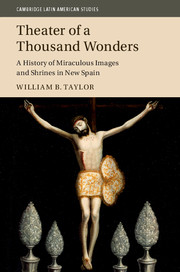Book contents
- Frontmatter
- Dedication
- Contents
- List of Figures
- List of Maps
- List of Tables
- Preface and Acknowledgments
- Archive Abbreviations
- Introduction
- Part I Bearings: Historical Patterns and Places of Image Shrines
- 1 Formative Developments, 1520s–1720s
- 2 Growth, Other Changes, and Continuities in the Late Colonial Period
- 3 Miraculous Images of Christ and the Virgin Mary
- 4 Advocations of the Virgin Mary in the Colonial Period
- Part II Soundings: Divine Presence, Place, and the Power of Things
- Conclusion
- Appendix 1 Colonial Image Shrines
- Appendix 2 When Shrines Began
- Appendix 3 Other Saints
- Index
4 - Advocations of the Virgin Mary in the Colonial Period
from Part I - Bearings: Historical Patterns and Places of Image Shrines
Published online by Cambridge University Press: 05 September 2016
- Frontmatter
- Dedication
- Contents
- List of Figures
- List of Maps
- List of Tables
- Preface and Acknowledgments
- Archive Abbreviations
- Introduction
- Part I Bearings: Historical Patterns and Places of Image Shrines
- 1 Formative Developments, 1520s–1720s
- 2 Growth, Other Changes, and Continuities in the Late Colonial Period
- 3 Miraculous Images of Christ and the Virgin Mary
- 4 Advocations of the Virgin Mary in the Colonial Period
- Part II Soundings: Divine Presence, Place, and the Power of Things
- Conclusion
- Appendix 1 Colonial Image Shrines
- Appendix 2 When Shrines Began
- Appendix 3 Other Saints
- Index
Summary
Marian shrine images are discussed in the preceding chapters mainly in terms of their place identities (Our Lady of Xuquila, etc.), but the advocations they depicted also informed how they were understood. For example, shrine images of Mary Immaculate such as La Purísima of Tecamachalco (Puebla) and Buctoz (Yucatán) continued to be identified by this advocation, and devotees of Our Lady of Guadalupe at Tepeyac often referred to her as “la Purísima.” Many images of the Blessed Mary were similar in pose and appearance so that an image of the Virgin might change advocation without much difficulty, but each advocation had a distinguishing feature, usually a symbol or setting, whether it was rosary beads, a candle, a scapular, a sword pointed at her heart, a crescent moon beneath her feet, or a backdrop of billowing clouds and cherubs or a fire-breathing monster. Different advocations traced different histories in New Spain, appealing to particular devotees and promoters, and being honored on different feast days that reminded devotees of the advocation's special attributes.
Advocations, then, are another dimension of the complex interplay of image and presence that often centered on a shrine image and sometimes defined it. Some advocations initially were associated with one of the religious orders – the Immaculate Conception with Franciscans; the Mater Dolorosa and Loreto with Jesuits; Our Lady of the Rosary with Dominicans – but became more widely known, promoted, and venerated. Others associated with an order, such as Our Lady of Carmen and the Carmelites or Our Lady of Mercy and the Mercedarians remained closely identified with that order and a more restricted audience. Some regional Spanish advocations in America preserved their peninsular identities in America; for example, the advocations of Pilar de Zaragoza, Aranzazú, Montserrat, and Covadonga appealed mainly to immigrant families from Aragón, the Basque provinces, Catalonia, and Asturias, respectively. But they could have other significance, too. Our Lady of Covadonga, for instance, was associated with the Dominicans as well as the Asturias homeland, and her role as divine warrior came to the fore in the eighteenth century as Spain's entanglements in European politics led to more international warfare. Another regional Spanish advocation, Our Lady of Cueva Santa, was less attached to immigrants from her home region of Valencia.
- Type
- Chapter
- Information
- Theater of a Thousand WondersA History of Miraculous Images and Shrines in New Spain, pp. 245 - 306Publisher: Cambridge University PressPrint publication year: 2016



